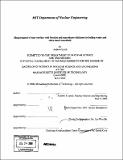Measurement of near-surface void fraction and macrolayer thickness in boiling water and silica-based nanofluid
Author(s)
Lerch Andrew (Andrew J.)
DownloadFull printable version (13.93Mb)
Other Contributors
Massachusetts Institute of Technology. Dept. of Nuclear Science and Engineering.
Advisor
Jacopo Buongiorno and Lin-Wen Hu.
Terms of use
Metadata
Show full item recordAbstract
Nanofluids are engineered fluids that contain a suspension of nanoparticles in a pure substance. Nanoparticles can be any variety of metals, metal oxides, or ceramics. They have been shown to increase heat transfer properties such as thermal conductivity, convective heat transfer, and critical heat flux(CHF). An optical probe used to detect phase was used to measure the void fraction during boiling, from which the macrolayer thickness can be derived. The optical probe was verified to have an error of 11.9% and 10.4% for measuring bubble diameter in water and R-123, respectively, and an error of 5.2% and 7.1% for measuring velocity in water and R-123. The macrolayer dryout theory of CHF was tested by investigating the change in macrolayer thickness for different heat fluxes in de-ionized (DI) water and 0.01% (by volume) SiO₂nanofluid. A current controlled power source heated a sandblasted, stainless steel plate resting in an isothermal bath. The silica nanofluid had a CHF enhancement of 82% over the DI water along with a slightly higher (20% enhancement) heat transfer coefficient. The macrolayer thickness, as measured by the optical probe, at a comparable heat flux was much larger than the DI water, possibly due to the increased wettability of the heater caused by the deposition of nanoparticles on the heater. This trend is in agreement with prediction of existing theory.
Description
Thesis (S.B.)--Massachusetts Institute of Technology, Dept. of Nuclear Science and Engineering, 2008. Includes bibliographical references (leaves 48-49).
Date issued
2008Department
Massachusetts Institute of Technology. Department of Nuclear Science and EngineeringPublisher
Massachusetts Institute of Technology
Keywords
Nuclear Science and Engineering.